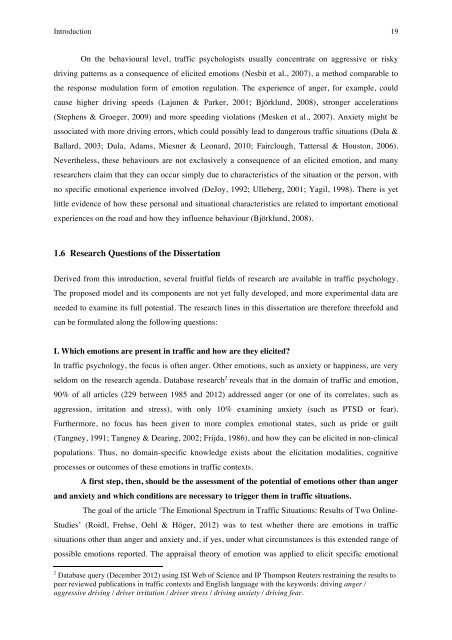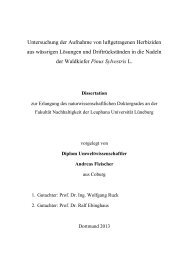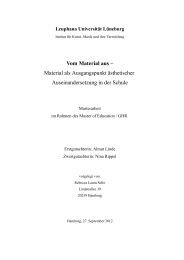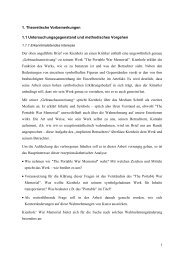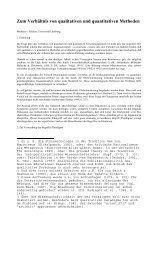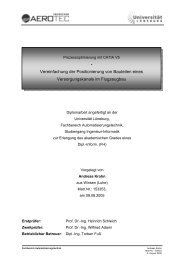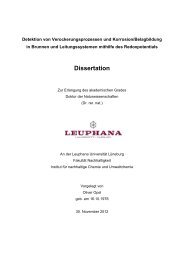Determinants of Emotional Experiences in Traffic Situations ... - OPUS
Determinants of Emotional Experiences in Traffic Situations ... - OPUS
Determinants of Emotional Experiences in Traffic Situations ... - OPUS
Create successful ePaper yourself
Turn your PDF publications into a flip-book with our unique Google optimized e-Paper software.
Introduction 19<br />
On the behavioural level, traffic psychologists usually concentrate on aggressive or risky<br />
driv<strong>in</strong>g patterns as a consequence <strong>of</strong> elicited emotions (Nesbit et al., 2007), a method comparable to<br />
the response modulation form <strong>of</strong> emotion regulation. The experience <strong>of</strong> anger, for example, could<br />
cause higher driv<strong>in</strong>g speeds (Lajunen & Parker, 2001; Björklund, 2008), stronger accelerations<br />
(Stephens & Groeger, 2009) and more speed<strong>in</strong>g violations (Mesken et al., 2007). Anxiety might be<br />
associated with more driv<strong>in</strong>g errors, which could possibly lead to dangerous traffic situations (Dula &<br />
Ballard, 2003; Dula, Adams, Miesner & Leonard, 2010; Fairclough, Tattersal & Houston, 2006).<br />
Nevertheless, these behaviours are not exclusively a consequence <strong>of</strong> an elicited emotion, and many<br />
researchers claim that they can occur simply due to characteristics <strong>of</strong> the situation or the person, with<br />
no specific emotional experience <strong>in</strong>volved (DeJoy, 1992; Ulleberg, 2001; Yagil, 1998). There is yet<br />
little evidence <strong>of</strong> how these personal and situational characteristics are related to important emotional<br />
experiences on the road and how they <strong>in</strong>fluence behaviour (Björklund, 2008).<br />
1.6 Research Questions <strong>of</strong> the Dissertation<br />
Derived from this <strong>in</strong>troduction, several fruitful fields <strong>of</strong> research are available <strong>in</strong> traffic psychology.<br />
The proposed model and its components are not yet fully developed, and more experimental data are<br />
needed to exam<strong>in</strong>e its full potential. The research l<strong>in</strong>es <strong>in</strong> this dissertation are therefore threefold and<br />
can be formulated along the follow<strong>in</strong>g questions:<br />
I. Which emotions are present <strong>in</strong> traffic and how are they elicited?<br />
In traffic psychology, the focus is <strong>of</strong>ten anger. Other emotions, such as anxiety or happ<strong>in</strong>ess, are very<br />
seldom on the research agenda. Database research 2 reveals that <strong>in</strong> the doma<strong>in</strong> <strong>of</strong> traffic and emotion,<br />
90% <strong>of</strong> all articles (229 between 1985 and 2012) addressed anger (or one <strong>of</strong> its correlates, such as<br />
aggression, irritation and stress), with only 10% exam<strong>in</strong><strong>in</strong>g anxiety (such as PTSD or fear).<br />
Furthermore, no focus has been given to more complex emotional states, such as pride or guilt<br />
(Tangney, 1991; Tangney & Dear<strong>in</strong>g, 2002; Frijda, 1986), and how they can be elicited <strong>in</strong> non-cl<strong>in</strong>ical<br />
populations. Thus, no doma<strong>in</strong>-specific knowledge exists about the elicitation modalities, cognitive<br />
processes or outcomes <strong>of</strong> these emotions <strong>in</strong> traffic contexts.<br />
A first step, then, should be the assessment <strong>of</strong> the potential <strong>of</strong> emotions other than anger<br />
and anxiety and which conditions are necessary to trigger them <strong>in</strong> traffic situations.<br />
The goal <strong>of</strong> the article ‘The <strong>Emotional</strong> Spectrum <strong>in</strong> <strong>Traffic</strong> <strong>Situations</strong>: Results <strong>of</strong> Two Onl<strong>in</strong>e-<br />
Studies’ (Roidl, Frehse, Oehl & Höger, 2012) was to test whether there are emotions <strong>in</strong> traffic<br />
situations other than anger and anxiety and, if yes, under what circumstances is this extended range <strong>of</strong><br />
possible emotions reported. The appraisal theory <strong>of</strong> emotion was applied to elicit specific emotional<br />
!!!!!!!!!!!!!!!!!!!!!!!!!!!!!!!!!!!!!!!!!!!!!!!!!!!!!!!!<br />
2 Database query (December 2012) us<strong>in</strong>g ISI Web <strong>of</strong> Science and IP Thompson Reuters restra<strong>in</strong><strong>in</strong>g the results to<br />
peer reviewed publications <strong>in</strong> traffic contexts and English language with the keywords: driv<strong>in</strong>g anger /<br />
aggressive driv<strong>in</strong>g / driver irritation / driver stress / driv<strong>in</strong>g anxiety / driv<strong>in</strong>g fear.<br />
!


